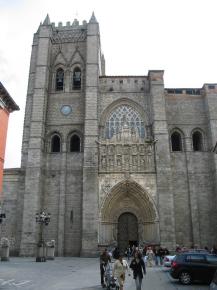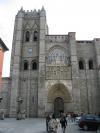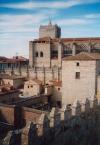The 12th-century Avila Cathedral
The 12th-century Avila Cathedral is a strong, fortress-like cathedral adjoining the famous medieval walls of Ávila.The construction on Avila Cathedral began in 1095 shortly after the Reconquest. The earliest parts were in the Romanesque style and built like a fortress - in fact, the apse ("Cimorro") is built right into the city walls.
Dedicated to San Salvador, Avila Cathedral is truly a cathedral-castle, with battlements and sentry walks incorporated into the structure. It's not just for looks, either - in the 12th century, Bishop Sancho protected the young Alfonso IX until he became king.
Most of the cathedral that can be seen today was built between the 12th and 14th centuries. During this time, the trend moved from Romanesque to Gothic styles, and the transition can be clearly seen in the interior. Visit also the Cathedral Museum.
What to See:
- The west facade looks quite lopsided - the cathedral remains unfinished and the south tower was never built.
- Inside, visitors can see the change from Romanesque to Gothic in action — the earlier Romanesque parts are made of a red-and-white stone, while the Gothic parts were built with pure white stone. The Gothic half of the cathedral seems more spacious, yet the proportions are exactly the same.
- The coro (choir) and two chapels in the left aisle date from the Renaissance. The elegantly carved stalls of the choir are the work of a Dutch sculptor, Cornelius. Here also is the marble tomb of a 15th-century bishop dubbed El Tostado ("The Toasted," for his skin tone).
- The main chapel has a magnificent reredos by Vasco de la Zarza and paintings by Berruguete and Juan de Borgoña. The stained glass is from the 15th century.
- Other highlights of the interior include the 13th-century sacristy, with a star-shaped cupola and gold inlay, and the treasury, with a huge silver monstrance and ancient religious icons

 Images
Images





Your comments